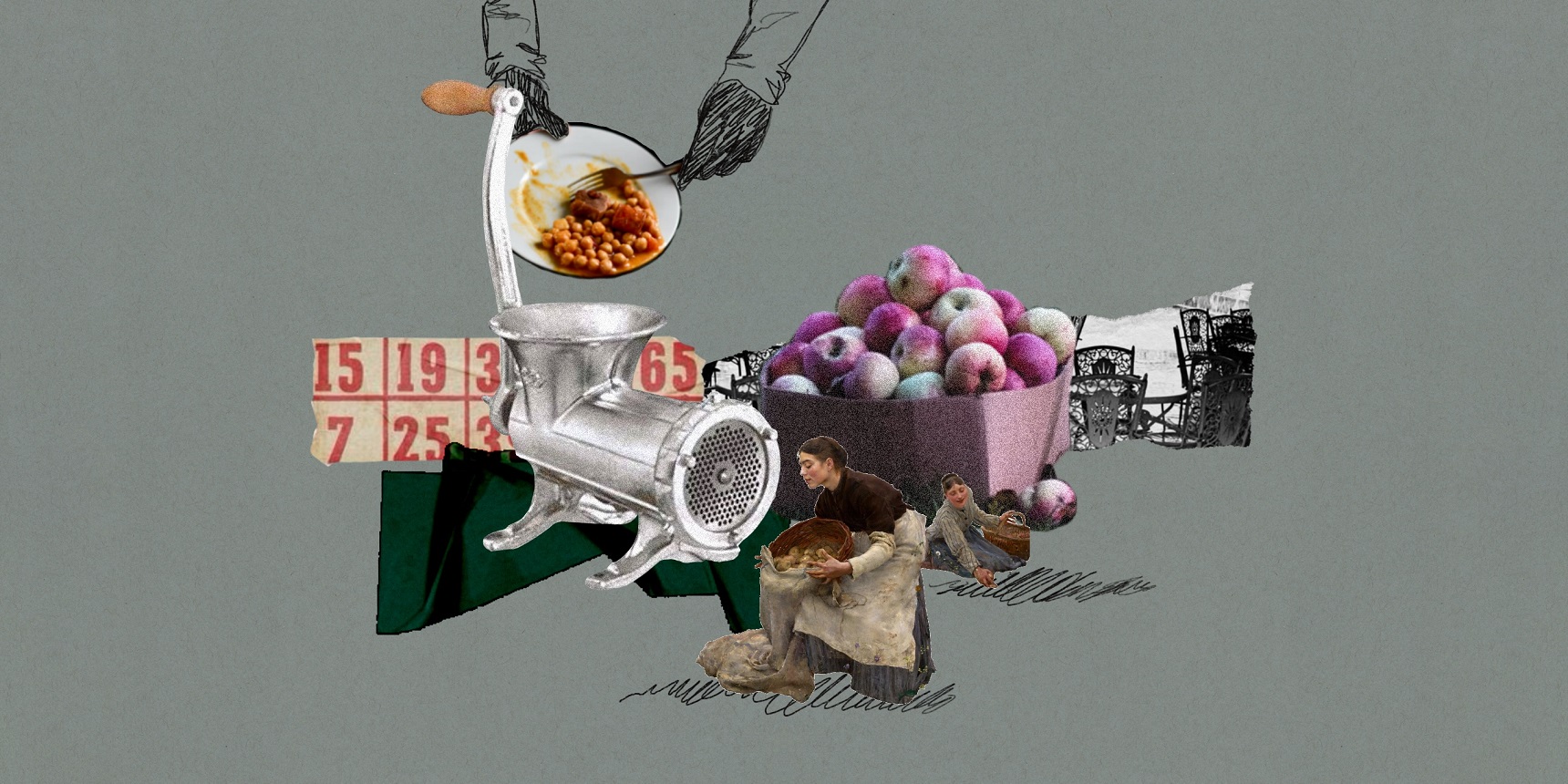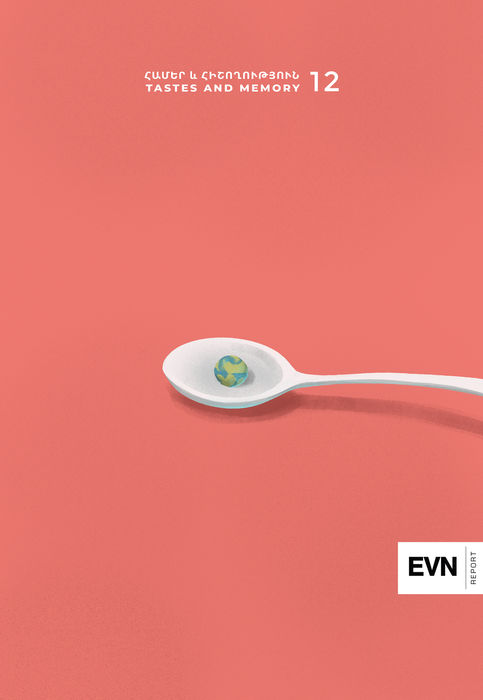
“Hey, did you see? There are apples scattered in front of your store!!” I said to the owner of a small vegetable shop near Tashir Center. He didn’t pay much attention to me and continued scrolling his social media. “I know, I know,” he replied. “They fell when we were carrying them. Let them stay there. I won’t be able to sell those, they’re spoiled.”
I asked if I could have a plastic bag and take them myself. He stopped scrolling and looked at me with a surprised face but replied positively, handing me a bag.
I gathered the apples from the ground and hung them on the hook of Sanitek’s trash bins. I realized that the next time I see something similar, I may not have the energy to intervene.
Poverty in society comes with many different side effects, including ignorance and mismanagement of resources you already have.
Yerevan, a city of contrasts, is squeezed into 223 square kilometers. It is a place where one can see an unbelievable number of luxurious cars on one narrow street, while the neighboring street depicts the lowest level of poverty.
Although the city has become more vibrant and active in recent years, with new places and a diverse atmosphere, poverty has not disappeared. It has simply been hidden away, just like the other traumas we have.
According to unofficial and official data, around 50% of the waste ending up in landfills is organic.
According to the UN, 27% of people in our country are poor, and 23% are food insecure. But, cases like this show that the government has not yet regulated this issue and does not even consider it a priority.
Irina Mkrtchyan is a marketing and waste management expert, and a co-founder of Innovative Solutions for Sustainable Development of Communities NGO, an organization educating communities on food waste in Yerevan and Armavir region “As far as I know there is no specific data in Armenia that highlights where the biggest amount of waste is coming from,” she explains. “But, generally speaking, it is mostly grocery stores. Expired products are often thrown away, while in many countries there are regulations that address this issue. Days before expiration, the food can be donated or even sent back to the producers. In Armenia, it mostly ends up in the landfill.”
Food waste is primarily caused by a misunderstanding of expiry dates and how they can affect the quality of food. Another significant factor is the appearance of the food. “Ugly” food, which I am trying to describe politely and correctly without offending it, often goes untouched. For example, in Europe, there are several social projects that primarily focus on this factor. One of these projects is the German initiative “Culinary Misfits”, which seeks out “ugly” vegetables at grocery stores, farmers’ markets, and restaurants, and transforms them into delicious dishes.
Both these cases can also be applicable in Armenia, but we face a different problem here: unnecessary food waste. Our traumatic unresolved conflict with hunger and poverty has transformed into a set of strange, sometimes hyper-consumerist behaviors, despite the abundance of products and opportunities in the present day. On one hand, this behavior may seem illogical, but in reality, it could be a stage that society needs to go through before healing, acceptance, and improvement.
Irina observes that our peculiar behavior with available resources, often resembling total mismanagement, is particularly evident during major holidays, “Just to show off, to prove to their neighbors that they have money and live well, people buy enormous amounts of food that they’re not going to consume,” she says. “I think a step towards change in our society would be to buy as much food as needed. Especially for holidays.”
Overconsumption is still seen by the majority of our society as a sign of wealth. These images may be a consequence of a constant cultural shock, poorly executed transition from USSR collectivism to capitalistic values, and influenced with the 1990s notions of “luxury”, “VIP” and “elite”, which were primarily different forms of oligarchic chic.
To flip this idea it is necessary to have not only goodwill, but also a constant and strategic educational intervention and collaboration with society.
Irina suggests that while educating people about the harmfulness of food waste and its environmental impact is a good start, highlighting the direct financial implications may be even more effective. “By pointing out the amount of money lost through waste and the potential earnings from repurposing food waste, we can encourage a productive approach to dealing with this problem,” she explains. “But it’s also important to provide people with the knowledge and tools to effectively manage waste. Additionally, it is crucial for all organizations and individuals invested in this issue to adopt a unified strategy and approach. This will make it easier to persuade people to change their consumption habits.”
Changing our consumer habits also requires going through stages of self-learning and acceptance. According to Hrachuhi Arakelyan, a transformational psychologist, our current habits are strongly influenced by the social stigma of the 1990s and the traumatic experience of poverty. This, paired with today’s sense of abundance, creates a peculiar attitude towards resources.
“On the surface, we may look great and talk about having yachts as goals, but deep down, we continue to purchase products as if preparing for a blockade and accumulate items that we know we won’t use, because we’re afraid to throw them away,” she says.
From her perspective, when we stop being afraid of the “less”, we’ll stop striving for the “more”.
The psychology of class is currently of interest not only to Armenians or countries that experienced the collapse of the USSR, but also the United States. The relatively new opinion series in The New York Times called “Fortunes” shares many personal stories written by people who have faced different class-related traumas, including poverty.
This approach would likely be a great way for Armenians to understand patterns of behavior. It could partially fulfill what Hrachuhi suggests, but in a more collective and media-guided manner.
Harutyun Kirakosyan, gastronomist, and founder and editor-in-chief of YerevanResto Magazine shares a different perspective:
“I think if we frame wasting food as a moral issue, it will resonate with locals because that’s something they understand how to address. Alternatively, the idea of wasting could be presented as “mauve ton”*, something “amot” (shameful), and “uncool”, which would also be effective because people always want to be cool. I’m confident that this approach would be more successful, as our mentality differs from that of Europeans. And, it’s funny that the social consciousness and even portion sizes were shaped over 150-200 years of poverty. Their current habits are a result of learning from their past.”
Mischa Badasyan, a Zurich-based artist, food, and animal activist, also points out a big difference in mindset between Western countries and those that experienced the USSR. In the USSR, people still try to liberate themselves and find validation through consumption as a way to overcome their past.
After moving from Russia to Europe and settling in Zurich, Mischa discovered the abundance of volunteering projects that specifically focus on addressing food waste. He decided to join some of these projects. “Last year I did a big performance piece called DON’T WASTE – for an entire year, I refrained from grocery shopping and I was not allowed to enter cafes or restaurants. The only thing I was allowed to eat was the saved food,” he says
“Saved food” refers to the practice of collecting edible food that would otherwise go to waste from various places such as farms, produce markets, grocery stores, restaurants, or dining facilities, and distributing it to local emergency food programs.
Mischa adds: “In total, I have saved over 11 tons of food. I used to share my food with friends and neighbors, but I also provided food to homeless people and refugee shelters.”
Mischa founded an animal NGO – Armenian Animal Aid, which tries to raise awareness about food waste and its potential uses in cities.
Artistic activism can help raise awareness about food waste. However, as Irina mentioned, without a clear strategy and tools, these efforts can be in vain.
Many local businesses have started embracing a socially responsible mindset. For instance, Yeremyan projects have officially begun helping animal shelters. It is encouraging to see that even one of the major players in the Armenian market is actively engaged in charitable and responsible business practices.
Ashot Barseghyan, the chair of the Armenian Restaurant Association, holds a different view on the increasingly popular corporate responsibility mindset. He believes that, “bringing a PR strategy for a business to a social mindset requires a lot of effort and mostly in changing people’s mentality.”
“Just paying taxes, not harming the environment, and managing your resources well is sufficient for businesses in Armenia at this point,” he says. “I don’t think they should also be responsible for things that are more within the government’s purview, such as poverty, while food waste is everyone’s concern.”
Currently in Armenia, food waste is an issue that is being addressed at the individual level. While some stores choose to manage it, others do not. Even larger supermarket chains have only recently started using dynamic pricing as a way to quickly sell almost expired food.
Some cafes are choosing to minimize their loss and waste by repurposing leftovers as side dishes or sauces. For example, Baguette & Co offers discounts on their bread after 8 p.m. This approach could serve as a great example for many bakeries in town, although not all of them adopt this practice.
Sometimes small grocery stores can provide surprisingly good examples. For example, a vegetable shop at the intersection of Vardanants and Hanrapetutyan streets also has a fresh approach to reduce losses and maintain food circulation. Another noteworthy example is Apple Garden, a small stand on Tigran Mets. This shop minimizes waste by selling products at large discounts and also provides food for those in need during closing hours.
Many event organizers, such as EventToura, the creator of the first wine fest in Armenia, have prioritized the development of a robust logistic system from the outset. This not only helps to minimize waste but also promotes social responsibility.
Their co-founder and managing director, Mary Badalyan says: “We knew that our idea of having a festival like this would attract attention both from critics and the gastronomic field in general. We anticipated the impact it could have on other businesses and decided to incorporate the element of social responsibility right from the start, aiming to set a trend. We make an effort to use recyclable materials for our promotion material and have implemented a strong logistic system to minimize food waste during the festival. This year, there was virtually no food waste because we placed small fridges in each booth and the participating cafes prepared food on the spot by request, without bringing or discarding any extra.”
Of course, many critics argue that hosting a wine and food festival in a country where a large percentage of people are poor could be insensitive, and suggest that the festival could instead serve as an opportunity for food donation. However, co-founder and creative director of the festival Nouneh Manoukyan holds a different opinion: “To be honest, including a ‘free food’ component may attract people who aren’t in need, and it doesn’t effectively fight poverty. Additionally, it adds complexity to the food distribution process. While it may be beneficial for public relations, it does not actually provide assistance. That’s why we have chosen to do something different.”
Nouneh says that each year, they are doubling their contribution to various charity organizations and allocating spots for them during the festival: “The festival attracts a large crowd, making it a great platform to raise awareness about certain issues. This year, our primary focus was on supporting Artsakh, as it is a priority issue for us. We couldn’t ignore the situation, and decided to help the best way we could, given our resources.”
According to the Food and Agriculture Organization of the United Nations, approximately one-third of the food produced in the world goes to waste –– a staggering statistic.
As a waste management specialist, Irina firmly believes that the concept of food banks would be a perfect fit for Armenia. First introduced in 1967 in the U.S., food banks are organizations or initiatives that collect and deliver food to community organizations, shelters, or individuals in need. These food banks establish partnerships with grocery stores, cafes, restaurants, and other establishments that have surplus food that would otherwise be discarded. Given the small size of Armenia, this can be a major advantage as it allows for easier organization and quicker results of our investment.
Especially in the current context of economic and political insecurity worldwide, regional wars, and the blockade and later ethnic cleansing of Artsakh, it is important to seriously consider making changes to our consumer habits. By doing so, we can become a more mindful society that respects its limited resources.
What can we do?
As individuals, we can:
- Only buy as much as we`ll eat
- Cut fresh produce in a way that doesn’t waste
- Sort our waste into organic and non-organic
- Compost or donate excess food
- Follow chefs with tips on reducing waste, such as ZeroWasteChef
Food establishments can:
- Donate food
- Implement dynamic pricing, and have a discount system
- Create active food-saving chats or channels on social media
* Derived from French “mauvais ton”, meaning “bad manners”, a phrase often used by Russian speaking individuals.
Magazine Issue N12
Taste & Memory
Let’s Have Eech
How an orphan from the Armenian Genocide returns to his native village and finds his sister and a recipe for eech that has become part of the family lore.
Read moreHarissa: Tradition and Resistance
Christian Armenian lore traces the origins of harissa to Gregory the Illuminator, who converted King Tiridates III to Christianity at the beginning of the 4th century. Hranoush Dermoyan traces the history of this traditional Armenian dish.
Read moreSourki and Banderoum Hootz: The Food of My Memories
A traditional cheese bread made with sourki or shinklish called banderoum hootz in the dialect of Musa Ler is more than a recipe. It’s a memory, a cultural marker of identity, belonging and home.
Read moreLittle Leaves
Preparing food can be a meditative journey of self-healing, of building community and a passage to one's heritage. It is the whispered world of women, a value created out of patience that can transform onions into translucent golden particles.
Read moreAlso see
Armenian Wine Traditions Rediscovered
The 2007 discovery of a 6,000-year-old winery in a cave in the Vayots Dzor region was an invitation for Armenians to rediscover their ancient wine-making traditions. Armenia’s once-forgotten wine culture began to reemerge and take on new forms.
Read moreInterrupted Flavors: Thoughts on Armenian Cuisine
Attitudes toward food and culinary art can reveal much about a people’s past and future. Ella Kanagerian writes that we are trying to work with our cultural influences and approach the concept of national cuisine more consciously.
Read moreArmenian Recycled Art: Imagine There’s No Garbage
Armenia produces a lot of garbage. Innovative artists throughout the country are taking that waste and turning it into art.
Read morePodcast
EVN Talks
How Do We Handle Our Waste?
Armenia has a waste management crisis. Harutyun Alpetyan, the lead expert for the AUA Acopian Center for the Environment’s Waste Governance in Armenia program, spoke to EVN Report about the development of a national solid waste governance policy, strategy and roadmap based on the principles of a circular economy.
Read more









